
Megachilidae is a cosmopolitan family of mostly solitary bees. Characteristic traits of this family are the restriction of their pollen-carrying structure to the ventral surface of the abdomen, and their typically elongated labrum. Megachilid genera are most commonly known as mason bees and leafcutter bees, reflecting the materials from which they build their nest cells ; a few collect plant or animal hairs and fibers, and are called carder bees, while others use plant resins in nest construction and are correspondingly called resin bees. All species feed on nectar and pollen, but a few are kleptoparasites, feeding on pollen collected by other megachilid bees. Parasitic species do not possess scopae. The motion of Megachilidae in the reproductive structures of flowers is energetic and swimming-like; this agitation releases large amounts of pollen.

Echeveria is a large genus of flowering plants in the family Crassulaceae, native to semi-desert areas of Central America, Mexico and northwestern South America.
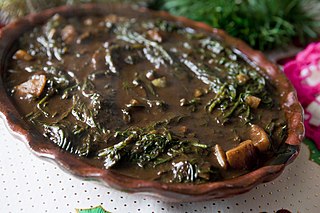
Romeritos is a Mexican dish from Central Mexico, consisting of tender sprigs of seepweed which are boiled and served in a mole sauce seasoned with shrimp jerky blended into the mix.

Megachile pluto, also known as Wallace's giant bee or raja ofu, is a large resin bee found in Indonesia. With a wingspan of 63.5 mm (2.5 in) it is the largest known living bee species. It was believed to be extinct until several specimens were discovered in 1981. No further sightings were confirmed until two specimens were collected and sold on eBay in 2018. A live female was found and filmed for the first time in 2019.
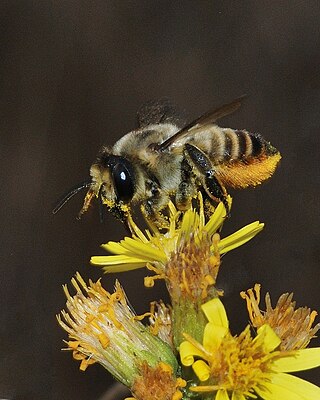
The genus Megachile is a cosmopolitan group of solitary bees, often called leafcutter bees or leafcutting bees; it also includes the called resin bees and mortar bees. While other genera within the family Megachilidae may chew leaves or petals into fragments to build their nests, certain species within Megachile neatly cut pieces of leaves or petals, hence their common name. This is one of the largest genera of bees, with more than 1500 species in over 50 subgenera. The alfalfa leafcutter bee is managed on a commercial scale for crop pollination, and has been introduced by humans to various regions around the world.
Oldenlandia pulvinata is a species of plant in the family Rubiaceae. It is endemic to Yemen. Its natural habitat is rocky areas.
Aciachne is a genus of Latin American plants in the grass family.
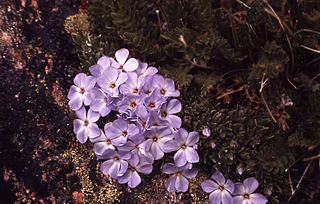
Phlox pulvinata is a species of phlox known by the common name cushion phlox. It is native to the western United States where it grows in mountain and plateau habitat, in rocky subalpine and alpine climates, including exposed tundra habitat. It is a perennial herb taking a flat, dense, cushionlike form on the ground. Its very short stems are lined with hair-fringed lance-shaped leaves each no more than one centimeter long. The plant is among the first to flower in the spring in many areas. It blooms densely, forming carpets of flowers. Each white to pale pink flower has a tubular throat up to one centimeter long and a flat five-lobed corolla.

Eudonia murana, the Scotch gray or wall grey, is a moth of the family Crambidae. It was described by John Curtis in 1827 and is found in most of Europe.
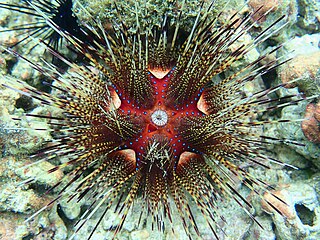
Astropyga pulvinata is a species of sea urchins of the family Diadematidae. Their armour is covered with spines. Astropyga pulvinata was first scientifically described in 1816 by Jean-Baptiste de Lamarck.
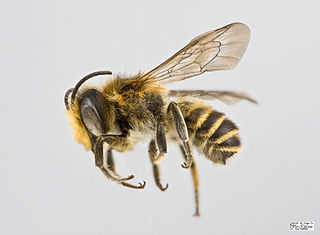
Megachile centuncularis, commonly known as the patchwork leafcutter bee, is a species of bee in the family Megachilidae. It was first described by the Swedish naturalist Carl Linnaeus in 1758.
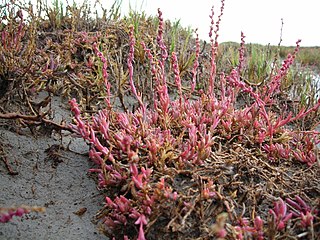
Suaeda pulvinata is an endemic seepweed from Mexico. It lives in the shores of Lake Texcoco and Lake Totolcingo. It lives underwater as an aquatic plant for half of the year and on dry land as a terrestrial plant for the other half due to the changing levels of the lakes that it inhabits. It is a perennial flat herb with prostrate stems. Its leaves and inflorescences are green to reddish in color.
Kratochvilia is a genus of spiders in the family Mimetidae. It was first described in 1934 by Strand. As of 2017, it contains only one species, Kratochvilia pulvinata, found on Príncipe.
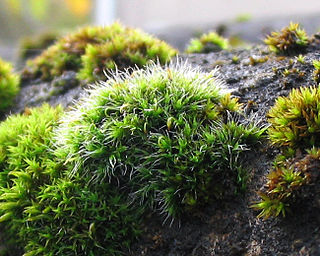
Grimmia pulvinata, otherwise known as grey-cushioned grimmia or pulvinate dry rock moss, is a bryophyte moss common in temperate climates worldwide.

Megachile pseudobrevis, the southeastern little leaf-cutter bee, is a species of hymenopteran in the family Megachilidae.
Megaphorus megachile is a species of robber flies in the family Asilidae.
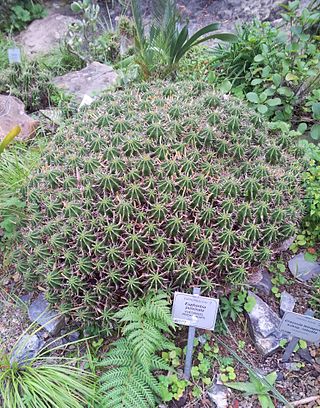
Euphorbia pulvinata, commonly known as the pincushion euphorbia, is a species of plant in the family Euphorbiaceae native to southern Africa.

Echeveria pulvinata, the plush plant, is a species of flowering plant in the genus Echeveria, native to southwest and central Mexico. A succulent, it has gained the Royal Horticultural Society's Award of Garden Merit. Its variety Echeveria pulvinata var. leucotricha, under the synonym Echeveria leucotricha, the chenille plant, has also gained the Award of Garden Merit.

Staurothele pulvinata is a species of saxicolous (rock-dwelling), squamulose lichen in the family Verrucariaceae. The lichen was first formally described in 1861 by Theodor Magnus Fries, as a member of genus Endocarpon. The type specimen was collected from northern Norway. The taxon was later transferred to Dermatocarpon by Gustav Wilhelm Körber in 1863, and to Polyblastia by Antonio Jatta in 1900. Starri Heiðmarsson moved it to Staurothele in 2017, based on molecular phylogenetic analysis that showed it belonged to that genus. It is one of few squamulose species in a genus comprising mostly crustose lichens. Staurothele pulvinata has an arctic-alpine distribution; it has been recorded from Europe, Greenland, Iceland, and the United States.














